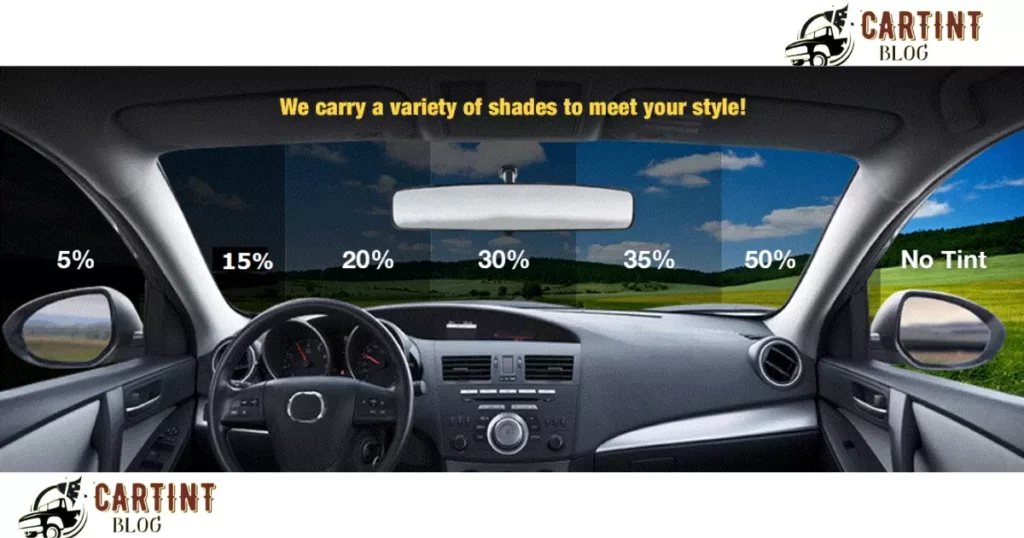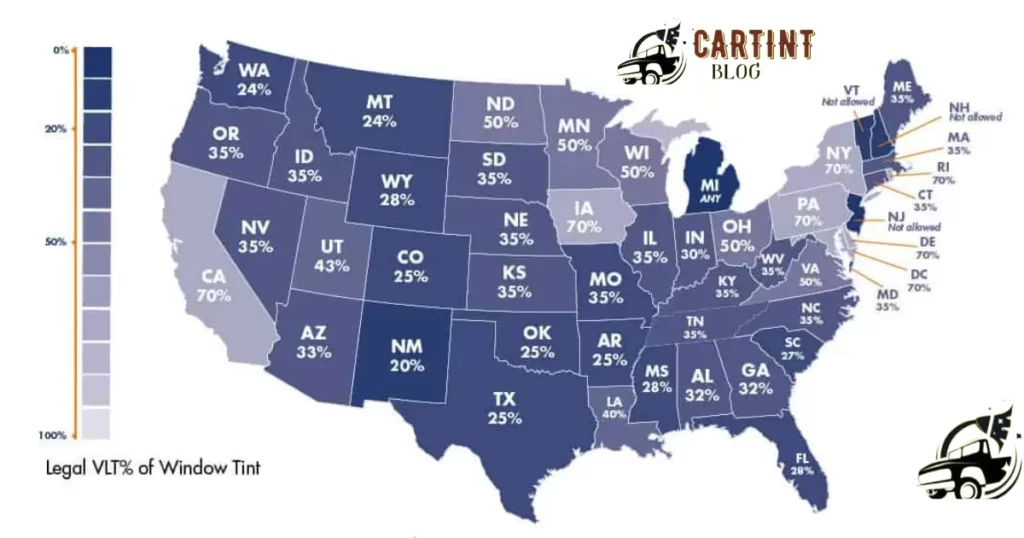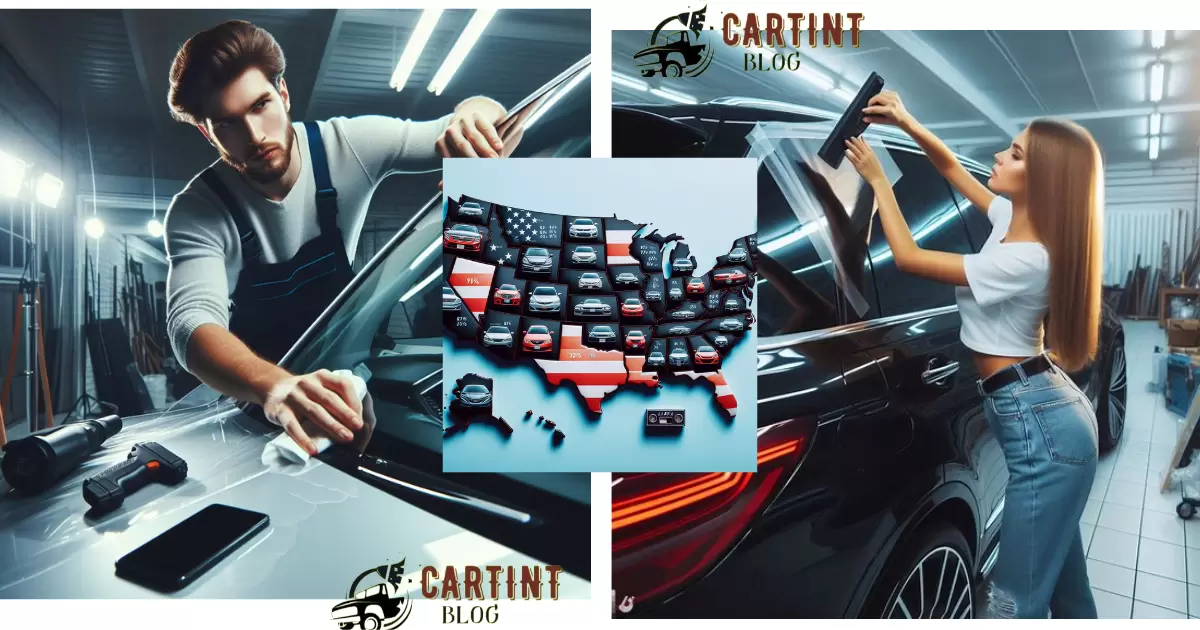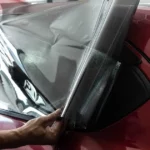Below is a complete breakdown of car window tint laws and legal tint percentages by state. Using this chart you can figure out which shade of tint is the right choice for you.
As you read these car tint laws, remember that window tint percentages refer to the amount of light allowed. It is also called the Visible Light Transmission (VLT) percentage.
Windshield tinting laws refer to the amount of windshield that can be legally tinted. Or the amount of tint allowed over the entire windshield depending on state regulations.
The accuracy, completeness, suitability, or currency of the Content is not guaranteed or guaranteed. We are not lawyers or law firms and we do not provide legal advice. If you want legal advice, we recommend that you consult an attorney or other appropriate professional.
Select your state from the list below to access detailed information. This data is regarding the regulations governing car window tinting in that specific jurisdiction.
How Dark Can You Tint Your Windows?

In the United States, car tint laws vary by state. As they regulating the darkness of window tinting to ensure safety and visibility. Each state has specific regulations dictating the permissible levels of tint darkness. Typically measured as a percentage of visible light transmission.
In California, the law allows a maximum of 70% tint darkness on the front side windows. While rear and back windows can have any darkness. In contrast, states like Arizona may permit a darker tint, such as 33% darkness on front side windows. Understanding and adhering to these tint laws is crucial to avoid legal consequences.
Violating tint regulations may result in fines. The requirement to remove and replace the tint to comply with the specified limits. Car owners should familiarize themselves with their state’s specific tint laws to ensure compliance and maintain road safety.
Window Tint Terminology
Window tint terminology refers to the terms and regulations associated with the application of window films on car windows. It’s crucial to understand terms like VLT (Visible Light Transmission) and tint percentages.
VLT indicates the amount of light that can pass through the tint. Laws often stipulate specific percentage limits for front, rear, and side windows.
Here are brief summaries of window tint regulations in seven different states in the USA
- California
- Front side windows 70% VLT
- Back side and rear windows Any darkness
- Texas
- Front side windows 25% VLT
- Back side and rear windows Any darkness
- New York
- Front side windows 70% VLT
- Back side and rear windows Any darkness
- Florida
- Front side windows 28% VLT
- Back side and rear windows Any darkness
- Illinois
- Front side windows 35% VLT
- Back side and rear windows Any darkness
- Arizona
- Front side windows 33% VLT
- Back side and rear windows Any darkness
- Georgia
- Front side windows 32% VLT
- Back side and rear windows Any darkness
Understanding the appropriate tint you need for a car is crucial. Regulations regarding tint levels may vary by state. To ensure compliance and evade fines, refer to the latest guidelines from state authorities. Staying informed is key to abiding by the law and maintaining legal tint limits for your vehicle.
Tint Laws By State Chart
The USA Car Tint Laws vary by state. Each state has specific regulations regarding the permissible level of tint for car windows. It’s crucial for vehicle owners to be aware of these laws. To ensure compliance and avoid potential fines or legal issues.
To make it easy for car owners, a Tint Laws By State Chart is available. This chart provides a quick reference to the tint regulations in each state. It make it convenient for individuals to determine the allowed tint levels for their car windows.
Here’s a formatted and detailed table based on the provided data
| State | Front Side Windows | Back Side Windows | Rear Windows | Windshield | Reflectivity | Other Restrictions |
| Alabama | 32% | 32% | 32% | 6 inches | No more than 20% reflective | None |
| Alaska | 70% | 40% | 40% | 5 inches | No metallic or mirrored tinting | No red, yellow, or amber tinting allowed |
| Arizona | 33% | Any | Any | Tinting allowed to the top of the manufacturer’s as-1 line | No more than 35% reflective | Red and amber not permitted. Back window tinting requires dual side mirrors |
| Arkansas | 25% | 25% | 10% | 5 inches | No metallic or mirrored tinting | None |
| California | 70% | Any | Any | 4 inches | No more reflective than standard window | No red, amber, or blue tinting. Dual side mirrors required for back tinted windows |
| Colorado | 27% | 27% | 27% | 4 inches | No metallic or mirrored tinting | No red or amber tinting. Back window tinting requires dual side mirrors |
| Connecticut | 35% | 35% | Any | Non-reflective tint above the as-1 line | No more than 21% reflective | Dual side mirrors required for back tinted windows |
| Delaware | 70% | Any | Any | Non-reflective tint above the as-1 line | No metallic or mirrored tinting | Dual side mirrors required for back tinted windows |
| Florida | 28% | 15% | 15% | Non-reflective tint above the as-1 line | No more than 25% reflective | Dual side mirrors required for back tinted windows |
| Georgia | 32% | 32% | 32% | 6 inches | No more than 20% reflective | No red or amber tinting allowed |
| Hawaii | 35% | 35% | 35% | No inch requirement, must allow 70% of light | No metallic or mirrored tinting | Dual side mirrors required for back tinted windows |
| Idaho | 35% | 20% | 35% | Tinting allowed to the top of the manufacturer’s as-1 line | No more than 35% reflective | Dual side mirrors required for back tinted windows |
| Illinois | 35% | 35% | 35% | 6 inches | Must be non-reflective | Dual side mirrors required for back tinted windows |
| Indiana | 30% | 30% | 30% | Tinting allowed to the top of the manufacturer’s as-1 line | No more than 25% reflective | None |
| Iowa | 70% | Any | Any | Tinting allowed to the top of the manufacturer’s as-1 line | No excessive reflections allowed | None |
| Kansas | 35% | 35% | 35% | Tinting allowed to the top of the manufacturer’s as-1 line | No metallic or mirrored tinting | No red, amber, or yellow tinting. Dual side mirrors required for back tinted windows |
| Kentucky | 35% | 18% | 18% | Tinting allowed to the top of the manufacturer’s as-1 line | No more than 25% reflective | None |
| Louisiana | 40% | 25% | 12% | Tinting allowed to the top of the manufacturer’s as-1 line | No more than 20% reflective | None |
| Maine | 35% | Any | Any | 4 inches | Must be non-reflective | Dual side mirrors required for back tinted windows |
| Maryland | 35% | 35% | 35% | 5 inches | No law | No red, amber, or yellow tinting. Dual side mirrors required for back tinted windows |
| Massachusetts | 35% | 35% | 35% | 6 inches | No more than 35% reflective | Dual side mirrors required for back tinted windows |
| Michigan | Any percent, but only 4 inches from the top of window | Any | Any | 4 inches | No more than 35% reflective | None |
| Minnesota | 50% | 50% | 50% | None allowed | No more than 20% reflective | None |
| Mississippi | 28% | 28% | 28% | Tinting allowed to the top of the manufacturer’s as-1 line | No more than 20% reflective | None |
| Missouri | 35% | Any | Any | Tinting allowed to the top of the manufacturer’s as-1 line | No more than 35% reflective | Dual side mirrors required for back tinted windows |
| Montana | 24% | 14% | 14% | Tinting allowed to the top of the manufacturer’s as-1 line | No more than 35% reflective | None |
| Nebraska | 35% | 20% | 20% | 5 inches or as-1 line, whichever comes first | No more than 35% reflective | Unclear on side mirrors, but no red, amber, or yellow tinting allowed |
| Nevada | 35% | Any | Any | Tinting allowed to the top of the manufacturer’s as-1 line | No law | Tinting allowed to the top of the manufacturer’s as-1 line |
| New Hampshire | No tinting allowed | 35% | 35% | 6 inches | No metallic or mirrored tinting | Dual side mirrors required for back tinted windows |
| New Jersey | No tinting allowed | Any | Any | No tinting allowed | No metallic or mirrored tinting | Dual side mirrors required for back tinted windows |
| New Mexico | 20% | 20% | 20% | 5 inches or as-1 line, whichever comes first | No law | Dual side mirrors required for back tinted windows |
| New York | 70% | 70% | Any | 6 inches | No metallic or mirrored tinting | Dual side mirrors required for back tinted windows |
| North Carolina | 35% | 35% | 35% | Tinting allowed to the top of the manufacturer’s as-1 line | No more than 20% reflective | No red, amber, or yellow tinting. Dual side mirrors required for back tinted windows |
| North Dakota | 50% | Any | Any | No more than 70% | No metallic or mirrored tinting | Dual side mirrors required for back tinted windows |
| Ohio | 50% | Any | Any | No more than 70% | No more reflective than standard window | None |
| Oklahoma | 25% | 25% | 25% | 5 inches or as-1 line, whichever comes first | No more than 20% reflective | Dual side mirrors required for back tinted windows |
| Oregon | 35% | 35% | 35% | 6 inches | No more than 13% reflective | No red, green, yellow, black, or amber tints. Dual side mirrors required for back tinted windows |
| Pennsylvania | 70% | 70% | 70% | None allowed | No metallic or mirrored tinting | Dual side mirrors required for back tinted windows |
| Rhode Island | 70% | 70% | 70% | Tinting allowed to the top of the manufacturer’s as-1 line | No law | None |
| South Carolina | 27% | 27% | 27% | Tinting allowed to the top of the manufacturer’s as-1 line | Must be non-reflective | No red, amber, or yellow tinting. Dual side mirrors required for back tinted windows |
| South Dakota | 35% | 20% | 20% | Tinting allowed to the top of the manufacturer’s as-1 line | No metallic or mirrored tinting | None |
| Tennessee | 35% | 35% | 35% | Tinting allowed to the top of the manufacturer’s as-1 line | No metallic or mirrored tinting | None |
| Texas | 25% | 25% | Any | 5 inches or as-1 line, whichever comes first | No more than 25% reflective | No red, amber, or blue tinting. Dual side mirrors required for back tinted windows |
| Utah | 43% | Any | Any | Tinting allowed to the top of the manufacturer’s as-1 line | No metallic or mirrored tinting | Dual side mirrors required for back tinted windows |
| Vermont | No tinting allowed | Any | Any | Tinting allowed to the top of the manufacturer’s as-1 line | No metallic or mirrored tinting | Dual side mirrors required for back tinted windows |
| Virginia | 50% | 35% | 35% | Tinting allowed to the top of the manufacturer’s as-1 line | No more than 20% reflective | No red, amber, or yellow tinting. Dual side mirrors required for back tinted windows |
| Washington | 24% | 24% | 24% | 6 inches | No more than 35% reflective | No red, green, yellow, black, or amber tints. Dual side mirrors required for back tinted windows |
| Washington D.C. | 70% | 50% (cars), 35% (multi-purpose vehicles) | 50% (cars), 35% (multi-purpose vehicles) | 5 inches or as-1 line, whichever comes first | No law | None |
| West Virginia | 35% | 35% | 35% | 5 inches | 20% reflective | No red, amber, or yellow tinting. Dual side mirrors required for back tinted windows |
| Wisconsin | 50% | 35% | 35% | Tinting allowed to the top of the manufacturer’s as-1 line | No law | Dual side mirrors required for back tinted windows |
| Wyoming | 28% | 28% | 28% | 5 inches or as-1 line, whichever comes first | No more than 20% reflective | Dual side mirrors required for back tinted windows |
Please note that this table provides a comprehensive overview of window tint laws. But it’s always a good idea to check for any recent updates or changes to the regulations in your state.
Tint Laws By State Map
The USA Car Tint Laws vary by state, and understanding them is crucial for vehicle owners. To navigate these regulations effectively, refer to the Tint Laws By State Map. This comprehensive resource provides exact information on permissible tint levels for each state, ensuring compliance with local regulations.
Stay informed about the specific tinting limits in your state by consulting the Tint Laws By State Map.

Why Is Window Tint Illegal In Some States?
Window tint is illegal in some states in the USA due to varying regulations on the permissible level of darkness. Each state establishes its own car tint laws to ensure safety and visibility standards. The restrictions aim to prevent excessive tinting that may compromise drivers’ ability to see clearly, especially during nighttime.
Window Tint Laws in the USA
In the United States, car tint laws vary from state to state. These regulations primarily concern the permissible levels of darkness for window tints on vehicles. It’s crucial for car owners to familiarize themselves with their state’s specific guidelines to avoid legal issues.
- Variability Across States
- Window tint regulations in the United States vary from state to state.
- Legal Limits
- Each state has specific legal limits regarding the darkness of window tint, measured as the Visible Light Transmission (VLT) percentage.
- Reasons for Restrictions
- The primary reasons for these regulations include ensuring road safety, visibility for law enforcement, and preventing potential criminal activities
Factors Influencing Tint Legality
Car tint legality in the USA is influenced by several key factors. State regulations play a crucial role, with each state having its specific laws regarding window tinting. The allowable tint darkness levels and reflection percentages vary. Understanding the specific regulations in your state is essential to ensure compliance.
- Medical Exemptions Some states allow medical exemptions for individuals with certain medical conditions that require increased protection from sunlight.
- Enforcement and Penalties Enforcement of window tint laws varies, and penalties for non-compliance may include fines or requiring tint removal.
- Continuous Updates Tint laws can change. So it is crucial for car owners to stay informed about the current regulations. In their state to avoid legal issues.
Can You Get Pulled Over For Having Tinted Windows?

Yes, you can get pulled over for having tinted windows in the USA. Car tint laws vary by state, so it’s crucial to know and adhere to the specific regulations in your location. In some states, there are restrictions on the darkness of window tint.
Violating these laws may result in traffic stops and fines. To avoid issues, familiarize yourself with the tinting regulations in your state. And ensure your car windows comply with the legal requirements.Professionalism is key when addressing car tint laws. Stay informed about the tint regulations applicable to your state, and take necessary measures to ensure compliance.
Traffic stops and fines can be avoided by adhering to the specific tinting guidelines established by your state’s laws. Being proactive in understanding and following these regulations will help you maintain a professional and lawful driving experience.
Is Limo Tint (Blacked Out Tint) Legal?
Limo tint, also known as blacked-out tint, may not be legal in many areas, including the USA. Car tint laws vary by state, and it’s crucial to understand and comply with the regulations to avoid legal issues. In the United States, each state has specific laws regarding the darkness of window tint. As it measured as a percentage of visible light transmission (VLT).
Violating these laws can result in fines and penalties. To ensure compliance, it is advisable to check your state’s specific regulations on car window tinting. Some states allow darker tints on rear windows while restricting the tint on front windows.
Understanding and adhering to these laws not only helps avoid legal consequences but also ensures a safer driving experience. As it maintains visibility for both the driver and law enforcement. Keep in mind that staying informed about local regulations is essential when considering any modifications to your vehicle’s tint.
California Window Tint Law
In California, the window tint law regulates the darkness of tinted windows on vehicles. The law specifies that non-reflective tint is allowed on the top four inches of the front windshield. For the front side windows, tint must allow at least 70% of light to pass through.
Rear side windows and the back windshield can have any darkness of tint.In the context of USA car tint laws, it’s crucial to note that each state may have its own regulations. Therefore, individuals should be aware of and comply with the specific window tint laws.
They should do this in their state to avoid legal consequences and ensure road safety. Always check and adhere to the tinting limits to maintain compliance with local regulations.
Front Window Tint Law
In the United States, car window tint laws vary from state to state. Each state has specific regulations regarding the darkness of tint allowed on the front windows. It is essential for car owners to familiarize themselves with the tint laws in their particular state to ensure compliance.
Professionalism in adhering to these regulations is crucial, as violating tint laws may result in fines or other legal consequences. To stay informed, individuals should consult their state’s Department of Motor Vehicles or a reliable legal source. In order to obtain accurate and up-to-date information on front window tint limits.
Being aware of and following these regulations helps maintain road safety and ensures a hassle-free driving experience.
What Are The Differences Between 35%, 20%, and 5% Tint?
When comparing 35%, 20%, and 5% car tint, the key distinction lies in light transmission levels. A 35% tint allows more light to pass through than a 20% tint. And both of these permit more visibility than a 5% tint. It’s crucial to consider local car tint laws to ensure compliance with regulations.
| Tint Percentage | Visibility | UV Protection | Legal Limits (Varies by State) |
| 35% | Moderate | Yes | Check State Regulations |
| 20% | Reduced | Enhanced | Front 70-90%, Rear Varies |
| 5% | Minimal | Maximum | Varies by State |
In What State Is 5% Tint Legal?
Car tint laws vary by state, and it’s crucial to be aware of the regulations to stay compliant. When it comes to 5% tint, commonly known as limo tint. It is generally not legal on front windows in many states. However, some states may permit it on rear windows and the back windshield.
To ensure you are in line with the law, check the specific tint regulations in your state. Keep in mind that violating tint laws can result in fines or other penalties. Stay informed and adhere to the tint regulations in your state to drive legally and avoid any potential consequences.
Medical Exemptions And Waivers For Window Tint
In the United States, car tint laws vary by state, and understanding medical exemptions and waivers is crucial. These exemptions allow individuals with specific medical conditions to use window tint beyond the usual legal limits.
If a person has a medical condition that makes them sensitive to sunlight, they may qualify for a medical exemption. To obtain a medical exemption for window tint, individuals typically need to provide documentation from a licensed medical professional detailing the condition and its impact on sensitivity to light.
It’s essential to familiarize yourself with the specific regulations in your state, as the requirements for medical exemptions can differ. Consulting with local authorities or legal professionals ensures compliance with the law while addressing individual medical needs.
Window Tint Laws FAQs
Are there legal restrictions on window tinting?
Yes, legal restrictions on window tinting vary by state. Refer to your state’s regulations for specific guidelines.
What is the darkest legal tint?
The darkest legal tint varies by state but is generally around 20% to 35%, with specific regulations on front, back, and rear windows.
How do I make my tint look darker?
The appearance of window tint can be enhanced by choosing a film with a lower visible light transmission (VLT) percentage.
Is limo window tint illegal?
The use of limo or extremely dark window tint is often illegal as it usually surpasses the maximum allowable VLT percentage set by state regulations.
Is 30 percent tint dark?
A 30 percent tint is considered moderately dark, offering privacy without significantly limiting visibility both during the day and night.
How do cops know if your tint is too dark?
Law enforcement uses tint meters to measure the VLT percentage, ensuring compliance with state regulations on window tint darkness.
What’s the darkest window tint percentage?
The darkest legal window tint percentage varies by state but typically ranges from 5% to 15%, with specific restrictions on different windows.
Conclusion
In the upcoming year, staying informed about the 2023-2024 window tint laws by state is key for vehicle owners. This comprehensive chart serves as a valuable resource, offering a clear snapshot of the regulations across different states.
From tint percentages to specific rules, this chart simplifies the complex landscape of window tint laws, empowering individuals to make informed decisions about their vehicle’s window tinting.
As we navigate the road ahead, having a handy reference like the 2023-2024 Window Tint Laws By State Chart ensures compliance with local regulations. Keeping abreast of these laws not only enhances safety but also helps drivers avoid potential legal complications. Stay knowledgeable, drive confidently, and enjoy the benefits of tinted windows within the bounds of the law.



